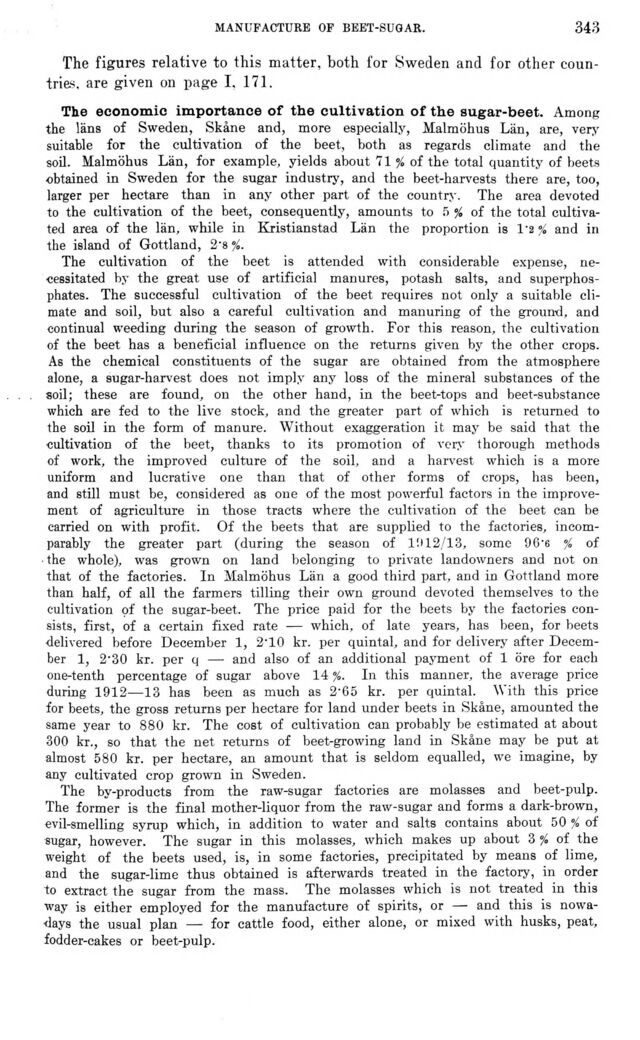
Full resolution (JPEG) - On this page / på denna sida - VII. Manufacturing Industries. Introd. by [G. Sundbärg] K. Åmark - 1. Articles of Food and Consumption. Introd. by Alf. Larson - Manufacture of Beet-Sugar. By Å. G. Ekstrand

<< prev. page << föreg. sida << >> nästa sida >> next page >>
Below is the raw OCR text
from the above scanned image.
Do you see an error? Proofread the page now!
Här nedan syns maskintolkade texten från faksimilbilden ovan.
Ser du något fel? Korrekturläs sidan nu!
This page has never been proofread. / Denna sida har aldrig korrekturlästs.
manufacture of beet-sugar.
343
The figures relative to this matter, both for Sweden and for other
countries, are given on page I, 171.
The economic importance of the cultivation of the sugar-beet. Among
the läns of Sweden, Skåne and, more especially, Malmöhus Län, are, very
suitable for the cultivation of the beet, both as regards climate and the
soil. Malmöhus Län, for example, yields about 71 % of the total quantity of beets
obtained in Sweden for the sugar industry, and the beet-harvests there are, too,
larger per hectare than in any other part of the country. The area devoted
to the cultivation of the beet, consequently, amounts to 5 % of the total
cultivated area of the län, while in Kristianstad Län the proportion is 1’2% and in
the island of Gottland, 2-8 %.
The cultivation of the beet is attended with considerable expense,
necessitated by the great use of artificial manures, potash salts, and
superphosphates. The successful cultivation of the beet requires not only a suitable
climate and soil, but also a careful cultivation and manuring of the ground, and
continual weeding during the season of growth. For this reason, the cultivation
of the beet has a beneficial influence on the returns given by the other crops.
As the chemical constituents of the sugar are obtained from the atmosphere
alone, a sugar-harvest does not imply any loss of the mineral substances of the
soil; these are found, on the other hand, in the beet-tops and beet-substance
which are fed to the live stock, and the greater part of which is returned to
the soil in the form of manure. Without exaggeration it may be said that the
cultivation of the beet, thanks to its promotion of very thorough methods
of work, the improved culture of the soil, and a harvest which is a more
uniform and lucrative one than that of other forms of crops, has been,
and still must be, considered as one of the most powerful factors in the
improvement of agriculture in those tracts where the cultivation of the beet can be
carried on with profit. Of the beets that are supplied to the factories,
incomparably the greater part (during the season of 11)12/13, some 96’6 % of
the whole), was grown on land belonging to private landowners and not on
that of the factories. In Malmöhus Län a good third part, and in Gottland more
than half, of all the farmers tilling their own ground devoted themselves to the
cultivation of the sugar-beet. The price paid for the beets by the factories
consists, first, of a certain fixed rate — which, of låte years, has been, for beets
delivered before December 1, 2’10 kr. per quintal, and for delivery after
December 1, 2’30 kr. per q — and also of an additional payment of 1 ore for each
one-tenth percentage of sugar above 14 %. In this manner, the average price
during 1912—13 has been as much as 2’65 kr. per quintal. With this price
for beets, the gross returns per hectare for land under beets in Skåne, amounted the
same year to 880 kr. The cost of cultivation can probably be estimated at about
300 kr., so that the net returns of beet-growing land in Skåne may be put at
almost 580 kr. per hectare, an amount that is seldom equalled, we imagine, by
any cultivated crop grown in Sweden.
The by-products from the raw-sugar factories are molasses and beet-pulp.
The former is the final mother-liquor from the raw-sugar and forms a dark-brown,
evil-smelling syrup which, in addition to water and salts contains about 50 % of
sugar, however. The sugar in this molasses, which makes up about 3 % of the
weight of the beets used, is, in some factories, precipitated by means of lime,
and the sugar-lime thus obtained is afterwards treated in the factory, in order
to extract the sugar from the mass. The molasses which is not treated in this
way is either employed for the manufacture of spirits, or — and this is
nowadays the usual plan — for cattle food, either alone, or mixed with husks, peat,
fodder-cakes or beet-pulp.
<< prev. page << föreg. sida << >> nästa sida >> next page >>